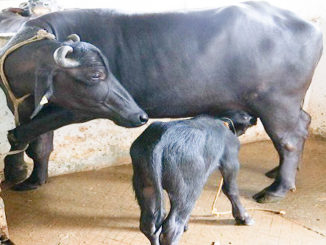Dystocia means difficult birth. It is an emergency. It necessitates its early handling by an obstetrician/V.O. in order to save the life of calf/ dam or both.
Causes of Dystocia
Basic causes
Hereditary, nutrition, management and infections.
Immediate causes
Maternal and fetal causes.
Maternal causes of Dystocia
(A) Torsion of uterus
It is the rotation of pregnant uterus along its longitudinal axis and is consider to be the single largest cause of maternal dystocia in buffaloes.
- In buffaloes the right side post-cervical uterine torsion is the commonest finding while in most cows the torsion was anti clock wise and pre-cervical also.
- The degree of torsion may vary from 450 to more than 7200 with majority (80%) cases between 180-2700.
Diagnosis
Based on history, clinical signs, general and specific examination.
History
The typical history given by the owner is usually that the cow had acted as if calving was imminent but true labor or straining has not occurred.
Clinical sign’s
Severe abdominal pain manifested as kicking at the belly, frequent straining with lying down and getting up are the initial cardinal signs. Moderate anorexia is present. Abdominal straining characteristics of 2nd stage is either absent or mild and intermittent. Letdown of milk and relaxation of pelvic ligaments is quite evident. If untreated, labor pains cease, appetite may become normal, milk is resorbed from the udder and pelvic ligaments get retightened.
General examination
Animal is anxious with increase respiration and heart rate (80 to 100 bpm). In advanced cases with complications of uterine gangrene/rupture or fetal emphysema, animal may be toxemic with very rapid, weak pulse, severe depression, weakness, prostration cold extremities and possible a fetid diarrhoea. In case of severe hemorrhage from ruptured uterine vessels, the animal exhibits anemia, weakness, rapid breathing, rapid pulse rate and prostration.
Specific examinations
Trans-vaginal: It reveals presence of vaginal folds either to the left or the right in post-cervical while cervix is approachable in pre-cervical torsion.
Trans-rectal: A rectal examination is mandatory to make a confirmatory diagnosis in case of pre-cervical uterine torsion and to rule out uterine adhesions with adjacent structures. The broad ligament ipsi-lateral to the side of torsion is pulled beneath where the contra-lateral one is stretched over the cervix. In case adhesions of uterus with other abdominal structures are present, the obstetrician will feel difficulty in passing his/her hand over the uterine surface in order to palpate the fetal parts.
Treatment
The most preffered method had been the schaffer’s plank method, in which dam is casted in lateral recumbancy to the side of torsion and the fetus is fixed with the help of a plank (12 feet length, 10 inch wide) kept in an inclined manner on the abdomen of the animal. The animal is rolled over to the other side (i.e. to the side of torsion) as a person keeps pressure on side of flank by standing on it, pressure on the end touching the ground was maintained with 2-3 persons standing on it while another person modulated the pressure on the other end of the plank. This sharma’s modified method was more successful (90%) as compared to older schaffer’s method (40%) of de-torsion.
Precaution
- After each rotation, it is mandatory to check the progress per- vaginaly.
- Maximum three rolling is advised.
(B) Incomplete Cervical Dilatation (I.C.D.)
Diagnosis
P/V examination reveals one/two finger dilatation.
Treatment
- Cortisol- Betamethasone (Betnesol)- 40 mg (10 amp)
- Estrogen – Estradiol valarate – (Progynon)– 30 mg (3 amp)
- Relaxin– Valethamide Bromide (Epidosin)–48mg(6amp)
- Prostaglandin– Cloprostenol sodium (Pragma)– 500 µg (2 ml)
Note: If fetus is live we can withdraw prostaglandin.
The above treatment takes about 12 to 48 or even 72 hours for complete cervical dilation.
(C) Uterine inertia
When contractions of uterus is weak /absent at the time of parturition from beginning of parturition or during second stage of labour.
Etiology /causes
- Hormonal imbalance
- Improper calcium/ magnesium ratio
- Over-streching due to oversize fetus
- Pathological condition of fetus
- Deplition of oxytocin
Clinical signs
Prolongation of first stage of labor and lack or absence of straining.
Treatment
- Correction of faulty disposition(PPP)
- Rupture of fetal membranes
- Adequate lubrication
- Gentle traction of fetus
- Inj. of calcium borogluconate (Mifex)-450 ml I/V
- Inj. of oxytocin (syntocinon)-25 I.U. I/M
(D) Pelvic Abnormalities
Stunted growth, rickets, depression of sacrum, fracture followed by callus formation, pelvic stenosis results in change of size and or shape of pelvis.
Correction
- Lubrication
- Traction
- Fetotomy
- caesarian section.
Reference
- Veterinary Reproduction and Obstetrics Tenth edition(2019) . David E. Noakes, Timothy J. Parkinson and Gary C. W. England
|
The content of the articles are accurate and true to the best of the author’s knowledge. It is not meant to substitute for diagnosis, prognosis, treatment, prescription, or formal and individualized advice from a veterinary medical professional. Animals exhibiting signs and symptoms of distress should be seen by a veterinarian immediately. |






1 Trackback / Pingback